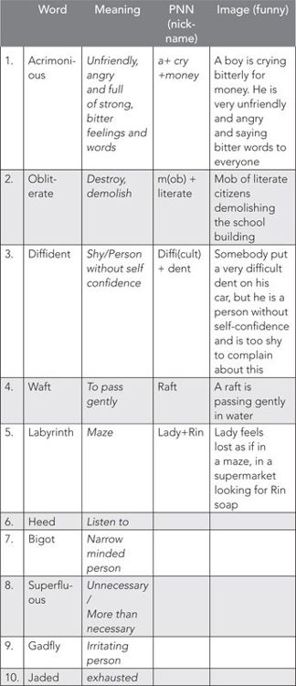How to Memorize Anything (15 page)
Read How to Memorize Anything Online
Authors: Aditi Singhal,Sudhir Singhal
Tags: #Self-Help, #Meditations

For example: let’s take the word:
‘Excruciate’
. It means
‘subject to intense pain or mental stress
’. Now we can read this word as ‘
a screw she ate
.’ To memorize this word, just imagine a lady who is in a lot of pain because of ‘a screw she ate’.
Let’s consider one more example:
‘Transient’
means
‘short lived or passing’
.
Now let’s break the word as tran+si+ent or train+see+ant. So you can imagine an ant crossing the railway track just when a train is about to pass. The train sees the ant just for a second and passes away.

Here are a few words for you to try and memorize using the above method. The first few have been done as examples.

I am sure you are able to memorize these words with ease and its meaning gets etched in your memory forever.
MEMORIZING SCIENTIFIC TERMS
This method can be used to memorize scientific terminology as well. For example, a medical student, who has to memorize the names of various bones in the human body, may find trouble with memorizing the names of the wrist bones i.e.
S
caphoid,
L
unate,
T
riquetrium,
P
isiform,
T
rapezium,
T
rapezoid,
C
apate,
H
amate.
Using the PNN method, one can convert difficult names of bones into simple pictures and use the chain or hide-and-seek method to arrange them in a sequence.
| Name of the Bones | Nicknames (PNN ) |
|---|---|
| Scaphoid | Scarf + avoid |
| Lunate | Too late |
| Triquetrium | Trick + aquarium |
| Pisiform | PC form (shape) |
| Trapezium | Trapezium (geometrical shape) |
| Trapezoid | Trap |
| Capate | Cap + ate |
| Hamate | Ham + ate |
VISUALIZATION
I
avoid
ed wearing a
scarf
as it was hot outside and I was getting
too late
. I was going to play a
trick
on my friends in an
aquarium.
The aquarium was in
PC form (shape).
Its entry gate was in the shape of a
trapezium.
Inside I saw a big
trap
where an octopus wearing a
Cap ate
fishes with
ham
and omelette.
In this way, a lot of information related to medicine, science, pharmacy, and other related studies can be made easier using this method, especially for students. Many more examples are given in the students’ section later in the book.
C
HAPTER AT A GLANCE
- Learning a foreign language is not just a trend but a necessity.
- By using the PNN method along with the AIR principle we can learn a foreign language in just a few days.
- When we try to learn the words of a foreign language, it is usually difficult as we cannot associate an image to it.
- The first step is to convert that word into a form that can be easily visualized.
- This can be done through PNN. Give a familiar nick name to that word.
- Now associate this nick name with the word’s meaning in English.
- For example: the Spanish word Cara (which means face in English) can be memorized as:
| English word | Spanish word | PNN(nick name) | Image (funny) |
|---|---|---|---|
| Face | Cara | Car | Spanish girls put lot of make-up on their face while driving a car. |
- This method can be used to learn not just a foreign language but to learn difficult English words or scientific terms as well.
For example, the meaning of Obliterate can be memorized as:
| Word | Meaning | PNN (nick name) | Image (funny) |
|---|---|---|---|
| Obliterate | Destroy, demolish | m(ob) + literate | A mob of literate citizens demolishing the school building. |
- Through this method you’ll be able to memorize the words better and faster and with more retentiveness.
8
MEMORIZING NAMES AND FACES
Someone asked an old man: ‘Even after 70 years,
you still call your wife
Darling…Jaan…Sweety….
Baby…Honey…Luv…!!!
What is the secret of this love?’
The old man replied: ‘
I forgot her name 10 years ago…
…and I’m scared to ask her.’
A
person’s name is his most prized possession, and there is nothing more pleasing to him than hearing his own name or having it remembered by others.
Although I doubt if any of you are as bad as the person in the anecdote, the most common complaint made by people who consider themselves to be in possession of a poor memory is that they are continually forgetting other people’s names. They remember the faces (as mentioned before, images are easy to recall), but the names fail to stick. This can be quite a concern, especially for those who work in an environment where they have to meet new people every day. In case you forget someone’s name, he/she might feel offended. Also, it is proven that people who remember names easily develop better personal relationships.
Would it not be an asset for any salesman to remember the names of his customers? Or for a doctor to remember the names of his patients, a lawyer, his clients, etc.? Of course, it would. Though everybody likes to achieve this quality, many fail to remember the names of people that they have met. They will remember having seen the person somewhere, but they are not able to locate the place or recollect their name. Sometimes they also fail to identify the person, because they just do not remember the face. The problem of forgetting names and faces is quite common but thankfully, it can be rectified.
HOW TO REMEMBER NAMES
It is not necessary that people only forget difficult or uncommon names. Most of the times the names are simple, but you are just not able to recollect it when you meet that person. It may be due to the fact that you were not paying enough attention while being introduced to the person or because you didn’t interacted much with that person. Here is a method through which you can remember as many names as you want in one day and can retain it for a much longer duration.
There are five simple steps to keep in mind while being introduced to someone for the first time, to remember his/her name forever:
STEP 1:
PAY ATTENTION TO THE NAME
The main reason why you are not able to recall someone’s name may be because
you didn’t hear it correctly
in the first place. So make sure you hear the name clearly. If not, ask the person to repeat it.
If it’s an odd-sounding name, you may
ask for the correct spelling and pronunciation as well
. Or try to spell it yourself; the person will correct you if you spell it incorrectly. Don’t think that person will be hurt. He will be happy that you are taking interest in him.
Make a remark about the name:
Whenever you hear anybody’s name for the first time, try to relate it with something good and make a remark on it or you can give that person a compliment as well, especially if the name is not very common or sounds unique. I remember about 5 years ago, I met a person at a stall of a publishing house at the International Book Fair in Delhi. His name was Reyansh. Although I was familiar with the meaning of the word, I hadn’t heard it being used as somebody’s name before. So I complimented him and said,
‘Wow! What a unique name! If I am not mistaken, it means God Vishnu’s ansh (part of God Vishnu). Isn’t it?’
‘Yes! You are right!’
he replied.
‘Actually my father’s name is Vishnu that is why he named me Reyansh.’
Because of this conversation, I still remember not just his name but his father’s as well. Complimenting someone on his name leaves an impression of that person’s face along with his/her name in your mind. Also, it is an effective tool to build interpersonal relations.
STEP 2:
CREATE A PICTURE OF THAT NAME IN YOUR MIND
After hearing the name clearly, try to give it a picture in your imagination. There are some names that are already meaningful and you can make a mental picture of it immediately like Gagan, Kamal, Prithvi etc.
Then there are certain names that do not have a clear and obvious meaning but they might remind you of someone else. It may be some famous personality or someone personally known to you. In such cases, you can associate this new person’s face with that of someone already known to you.
For example,
James
is a very common name in the US. You can visualize
James
(whom you met just now) posing as
James Bond
with a gun in his hand. Someone with the name
Anil
can be imagined in place of
Anil Kapoor (a Bollywood actor)
running around fighting terrorists like he does in the television series
24
.
In India,
Amit
is a very common name. I am sure you know at least one Amit. Let’s assume your younger brother’s name is Amit. In case you meet someone with the same name, you can imagine him as your brother.
There is a third category of names that do not have any meaning and do not create any picture in your mind. However, with the use of the
Personal Nick Name method
, a name can always be broken down into simpler familiar words and can be given an image.
For example
, a name like
Amolika
can be split as
Amul (butter) + lick
. An image of
a girl licking Amul butter
can be visualized.

I remember when I first met
Mr Swaminathan
, a memory trainer from Mumbai, I could immediately break his name into Swami + nath (Hindi word which means chief or head) and visualize him with a long beard touching his feet because he is the nath (chief) of all Swamis of the world. This helped me recollect his name for the first two-three meetings before it got stored in my long-term memory.
